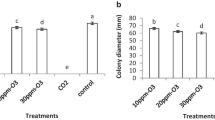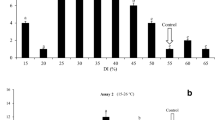Abstract
In New Zealand summer rots caused by Colletotrichum acutatum Simmonds (bitter rot) result in significant loss. This pathogen is currently controlled by fungicide sprays. This project was initiated to investigate if populations of naturally occurring yeast biological control agents could be enhanced by application of benign compounds in the field as an alternative means of control. Calcium chloride (CaCl2) and calcium carbonate (CaCO3) enhanced the biocontrol activity of applied yeasts against C. acutatum in detached fruit assays. Combining these compounds with yeasts resulted in a reduction of lesion size following inoculation by C. acutatum that was additive for some of the yeast-CaCl2 combinations and synergistic for some of the yeast-CaCO3 combinations. Calcium chloride was applied in the field in two trials conducted in different seasons and different regions. Disease incidence in the field was reduced by the application of CaCl2 in both trials. Results in a commercial orchard using CaCl2 at a rate of at 0.33 kg product /100 L were comparable to a standard fungicide spray programme. Investigation of the mode of action suggests direct fungistatic suppression by CaCl2, although there was evidence that treatment with CaCl2 increased resistance to infection in one apple variety.






Similar content being viewed by others
References
Beresford RM, Wearing CH, Walker JTS, Spink M, Marshall RR, White V (1995) Copper and slaked lime for the control of black spot and powdery mildew in apples. N Z Plant Prot 48:83–88
Biggs AR (1999) Effects of calcium salts on apple bitter rot caused by two Colletotrichum spp. Plant Dis 83:1001–1005
Boyd-Wilson KSH, Walter M (2009) The effects of calcium chloride and calcium carbonate on germination and growth of Colletotrichum acutatum and Penicillium expansum. Proceedings of the 17th Biennial Australasian Plant Pathology Society Conference, p. 138
Boyd-Wilson KSH, Glithero N, Ma Q, Alspach P, Walter M (2006) Yeast isolates to inhibit blue mould and bitter rot of apples. N Z Plant Prot 59:86–91
Boyd-Wilson KSH, Butler RC, Walter M (2010) Calcium chloride against black spot on apples. N Z Plant Prot 63:279 (poster)
Conway WS, Sams CE, Abbott JA, Bruton BD (1991) Postharvest calcium treatment of apple fruit to provide broad-spectrum protection against postharvest pathogens. Plant Dis 75:620–622
Conway WS, Janisiewicz WJ, Klein JD, Sams CE (1999) Strategy for combining heat treatment, calcium infiltration, and biological control to reduce postharvest decay of ‘Gala’ apples. HortSci 34(4):700–704
Damm U, Cannon PF, Woudenberg JHC, Crous PW (2012) The Colletotrichum acutatum species complex. Stud Mycol 73(1):37–113
Eastburn DM, Gubler WD (1990) Strawberry anthracnose: detection and survival of Colletotrichum acutatum in soil. Plant Dis 74(2):161–163
El-Ghaouth A, Smilanick JL, Wilson CL (2000) Enhancement of the performance of Candida saitoana by the addition of glycolchitosan for the control of postharvest decay of apple and citrus fruit. Postharvest Biol Technol 19:103–110
Everett KR, Machin T (2005) The efficacy of fungicides and biocontrol agents for control of Glomerella cingulata on Satsuma mandarins. N Z Plant Prot 58:84–88
Everett K, Vanneste J, Hallett I, Walter M (2005) Ecological alternatives for disease management of fruit rot pathogens. N Z Plant Prot 58:55–61
Everett KR, Timudo-Torrevilla OE, Taylor JT, Yu J (2007) Fungicide timing for control of summer rots of apples. N Z Plant Prot 60:15–20
Freeman S, Horowitz S, Sharon A (2001) Pathogenic and nonpathogenic lifestyles in Colletotrichum acutatum from strawberry and other plants. Phytopathology 91(10):986–992
GenStat Committee (2012a) GenStat Reference Manual Release 15 - Part 3, Procedures. VSN International, Oxford
GenStat Committee (2012b) The Guide to GenStat Release 15 - Parts 1–3. VSN International, Oxford
Hall BH, Jones MK, Wicks TJ (1998) First report of anthracnose of almond in South Australia. Australas Plant Pathol 27:127
Hickey KD, Conway WS, Sams CE (1995) Effect of calcium sprays and cultivar resistance on fruit decay development on apple. Pennsylvania Fruit News 75:37–40
Ippolito A, Schena L, Pentimone I, Nigro F (2005) Control of postharvest rots of sweet cheeries by pre- and postharvest application of Aureobasidium pullulans in combination with calcium chloride or sodium bicarbonate. Postharvest Biol Technol 36:245–252
Johnston PR, Pennycook SR, Manning MA (2005) Taxonomy of fruit-rotting fungal pathogens: what’s really out there? N Z Plant Prot 58:42–46
Jones AL, Ehret GR, Meyer MP, Shane WW (1996) Occurrence of bitter rot on apple in Michigan. Plant Dis 80(11):1294–1297
Kenward MG, Roger JH (1997) Small sample inference for fixed effects from restricted maximum likelihood. Biometrics 53:983–997
Lee Y, Nelder JA, Pawitan Y (2006) Generalized linear models with random effects: unified analysis via H-likelihood. Chapman & Hall/CRC Press, London
Lodder J, Kreger-van Rij NJW (1952) The yeasts: a taxonomic study. North-Holland Publishing Company, Amsterdam
McCullagh P, Nelder JA (1989) Generalized linear models, 2nd edn. Chapman & Hall, London
McLaughlin RJ, Wisniewski ME, Wilson CL, Chalutz E (1990) Effect of inoculum concentration and salt solutions on biological control of postharvest diseases of apple with Candida sp. Phytopathology 80:456–461
Nunes C, Usall J, Teixidó N, Miro M, Vinas I (2001) Nutritional enhancement of biocontrol activity of Candida sake (CPA-1) against Penicillium expansum on apples and pears. Eur J Plant Pathol 107:543–551
Payne R, Welham S, Harding S (2009) A Guide to REML in GenStat. VSN International, Oxford
Peres NA, Timmer LW, Adaskaveg JE, Correll JC (2005) Lifestyles of Colletotrichum acutatum. Plant Dis 89(8):784–796
Rahman M, Punja ZK (2007) Calcium and plant disease. In: Datnoff LE, Elmer WH, Huber DM (eds) Mineral nutrition and plant disease. APS Press, St. Paul, pp 79–93
Scherm B, Ortu G, Muzzu A, Budroni M, Arras G, Migheli Q (2003) Biocontrol activity of antagonistic yeasts against Penicillium expansum on apple. J Plant Pathol 85:205–213
Smith BJ, Magee JB, Gupton CL (1996) Susceptibility of rabbiteye blueberry cultivars to postharvest diseases. Plant Dis 80(2):215–218
Timewell E (2012) Pest management programme results in increased exports. Orchardist 85(6):11
Timudo-Torrevilla OE, Everett KR, Waipara NW, Boyd-Wilson KSH, Weeds P, Langford GI, Walter M (2005) Present status of strawberry fruit rot diseases in New Zealand. N Z Plant Prot 58:74–79
Zulfiqar M, Brlansky RH, Timmer LW (1996) Infection of flower and vegetative tissues of citrus by Colletotrichum acutatum and C. gloeosporioides. Mycologia 88(1):121–128
Acknowledgments
We thank Arier Lee and Sweta Baldawa for additional statistical advice. Thanks to Warwick Mottram (Lincoln University) for field assistance and Sunfruit Orchards (Rukuhia) for support. The New Zealand Foundation for Research Science and Technology (now the Ministry for Business, Innovation, and Employment) funded this project (C06X0302).
Author information
Authors and Affiliations
Corresponding author
Rights and permissions
About this article
Cite this article
Boyd-Wilson, K.S.H., Butler, R.C., Alspach, P.A. et al. Compounds alone and in combination with yeasts to control Colletotrichum acutatum in apples. Australasian Plant Pathol. 43, 703–714 (2014). https://doi.org/10.1007/s13313-014-0311-x
Received:
Accepted:
Published:
Issue Date:
DOI: https://doi.org/10.1007/s13313-014-0311-x




